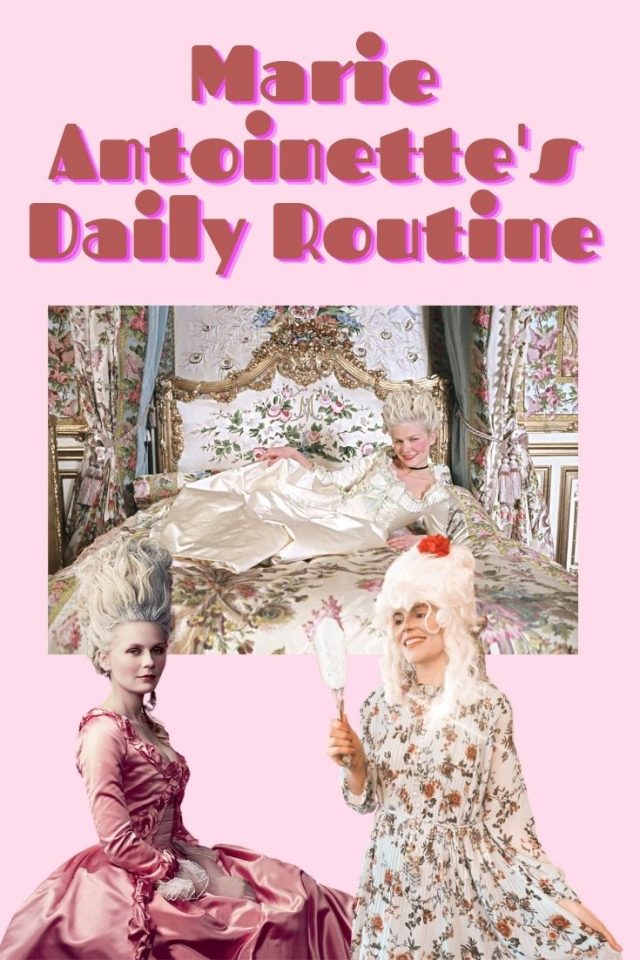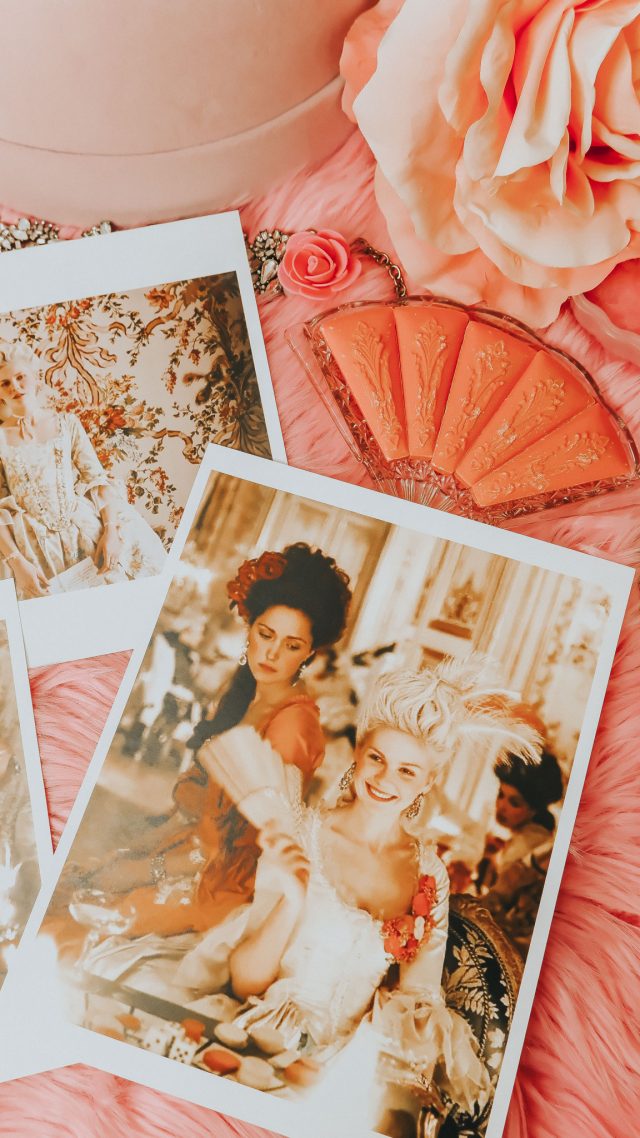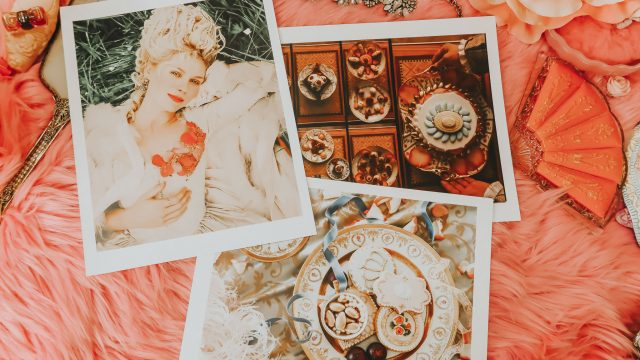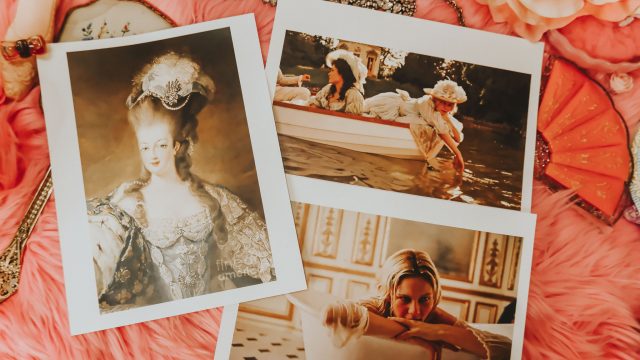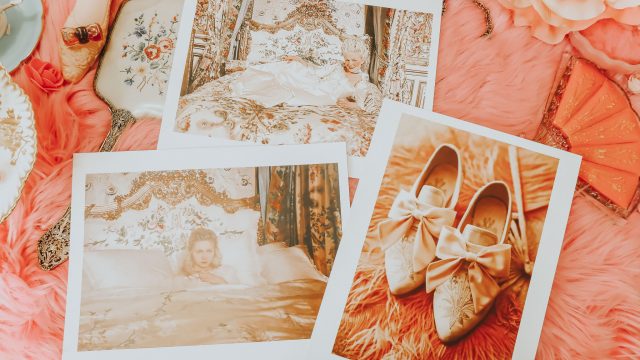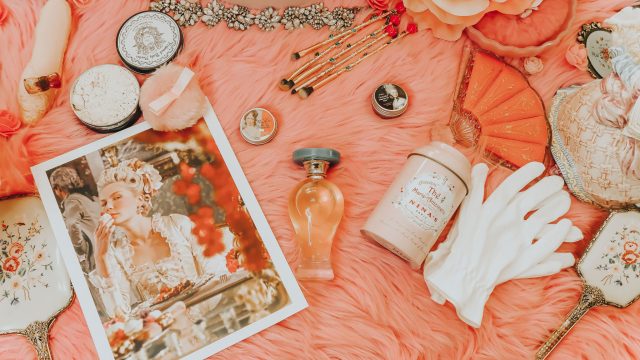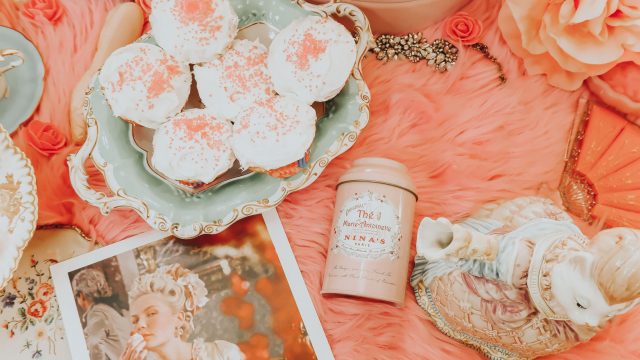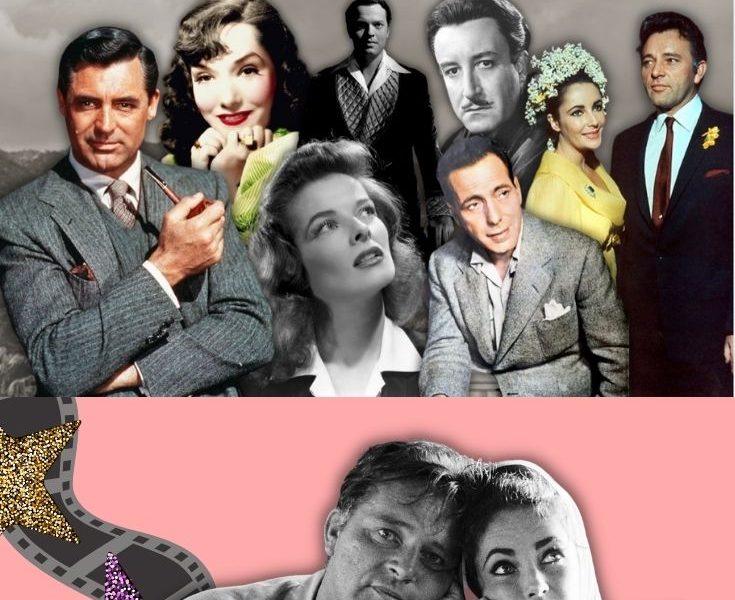Marie Antoinette’s Extravagant Daily Routine
Below is a daily schedule of the Queen’s extravagant daily routine.
8:00 am The Queen wakes.
A woman of the wardrobe arrives carrying a basket with what are called “offerings.” Offerings include two or three chemises, some handkerchiefs, some towels.
First, the waiting-woman arrives and presents a book known as gazette des atours, containing gowns’ fabric swatches. Each season has twelve toilets, twelve demi-toilets, and twelve rich dresses with panniers. The Queen selects the garments she will wear for the day by marking the swatches with pins. Her selections are delivered in large taffeta baskets and include “a full dress, an undress for the afternoon, an evening dress for the play and supper.”
The Queen wraps herself in a long robe of English flannel that is buttoned to the bottom.
The bath is rolled in, and bathers arrive with bathing items. When the Queen finishes her bath, a bath sheet is held to shield her from prying eyes and allows her to dry off in privacy.
She returns to bed wearing a white taffeta cloak and has either a piece of embroidery to work on or a book to read.
9:00 am Breakfast is served. It is placed on a tray on a coffee table and consists of something small, such as hot chocolate or coffee.
Intimates enter, and conversations ensue.
10:00 am The Queen visits the King’s aunts and then King.
11:00 am The Queen’s hair is dressed, and Louis XVI’s brothers usually arrive. Styles often include creations created by the Queen herself. For more on her hairstyles. After her hair is dressed, she curtsies to everyone in the room.
12:00
The Grand Toilette then begins with folding chairs placed in a circle for the household superintendent, ladies of honour, ladies of the bed-chamber, the children’s governess, princes of the blood, captains of the guard, and all the high officials who come to pay court. (Ladies of the palace arrive after the toilet is complete.) The Queen acknowledges each individual by a slight nod of her head.
The toilet table is very elaborate and placed in the center of the room. Getting ready for the day includes cleansing her skin with cosmetics, using astringents, and adding a whitener. White paint is then applied and dusted with a scented powder. Rouge reddens her cheeks, and pomade glosses her lips. Because the Queen suffered from smallpox as a child, she sometimes adds the ever-popular mouches. The finishing touch is one of the Queen’s favourite scents, usually Eau de fleur d’oranger, orange blossom water that she wears regularly.
A specific protocol is enacted for dressing the Queen as described:
“The lady of honour handed her chemise and poured the water for her to wash her hands; the lady of the bed-chamber passed the shirt of her gown or her full dress, arranged her fichu, and clasped her necklace.”
Moreover, nothing was ever passed directly to the Queen. If the Queen wanted a glass of water, it happened in this order:
“The lackey presented a silver-gilt platter to the first waiting-woman … but if the lady of honour appeared, it was she who offered the tray, and if [someone more important entered] … the tray was pass[ed] from the hands of the lady of honour to those of the [more important person] … before reaching the Queen.”
This complicated ceremony changed towards the end of the Queen’s reign: After her hair was dressed instead of dressing in the center of her room, she was followed only by her women into her boudoir. There she dressed and found “her modiste, Mademoiselle Bertin, the supreme arbiter of fashion.”
12:30 pm After the toilet is complete; the queen is accompanied by Princesse de Lamballe, “the ladies of honour and the bed-chamber, the ladies of the palace, her gentlemen-in-waiting, her chief equerry, her clergy, the princesses of the royal family.” She passes through the Salon de la Paix and the galleries on the way to mass. She and the King hear mass every day “in the tribune facing the high altar, except on days of full service, when she hear[s] it below on the carpet of velvet fringed with gold.”
1:00 pm The maître d’hôtel enters the Queen’s chambers announces dinner, and hands the Queen a menu. He is also responsible for supervising the service of dinner.
Dinner in public occurs every Sunday in the cabinet of the nobles. On that day, the ladies of the title who have the privilege sit on folding-chairs at either side of the table; the ladies without title remain standing. The Queen dines alone with the king; behind the king’s chair stands the captain of the guard and the first gentleman of the chamber; behind the queen’s chair stands her gentleman-in-waiting, her chief equerry, and her maître d’hôtel.
Dinner begins when the prince nearest the King presents a bowl to the King to wash his hands. The princess nearest the Queen performs this same service. The Queen usually dines on nothing more than a small portion of meat, and she never drinks wine. (The Queen once noted that dinner was a quick meal because “we both eat very fast.”)
1:30 pm After dinner, the Queen visits the dauphin’s apartment and then returns to her apartments with her women. She writes letters, attends to business, and reads. She also removes her pannier and the lower part of her robe. Some light gown, such as muslin or cotton, is then worn for the rest of the day.
3:00 pm The Queen revisits the King’s Aunts, and the King joins them.
4:00 pm The Abbé visits the Queen at her apartments.
5:00 pm The Queen has harpsichord or singing lessons.
6:00 pm The Queen visits the King’s aunts or takes a walk in the garden.
7:00 pm Activities such as playing cards or preparations for the evening — such as attending a play, a masked ball, or the opera — are prepared. The Queen also changes into an elaborate gown for the evening.
9:00 pm At supper, the Queen eats more than she does at dinnertime. Supper often includes “a little bouillon, the wing of a chicken, and a glass of water in which she dips some little biscuits.” If the king is not present, it is standard procedure for her to be served only by women.
11:00 pm A similar procedure to the morning procedure is repeated at bedtime. However, this time, the wardrobe woman brings a basket with a nightgown and nightcap. Stockings for the next morning are also delivered. After dressing for bed, whatever the Queen has worn is taken to the wardrobe room for repairs or cleaning. To maintain beautiful hands, the Queen often wears wax-lined gloves to bed.
The king also has a nighttime retiring ceremony known as a coucher. As the Queen waits for her husband and his attendants to arrive, her first femme de Chambre sits at the foot of her bed. After the coucher is complete, everyone leaves and then the femme de Chambre escorts the King’s men out and bolts the door. (Eventually, because the Queen began to stay up late, the Queen and King began to sleep in separate apartments, and the nighttime coucher was handled somewhat differently.)

